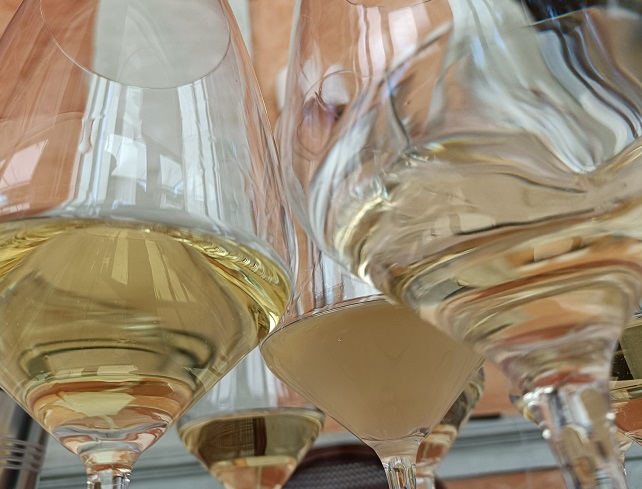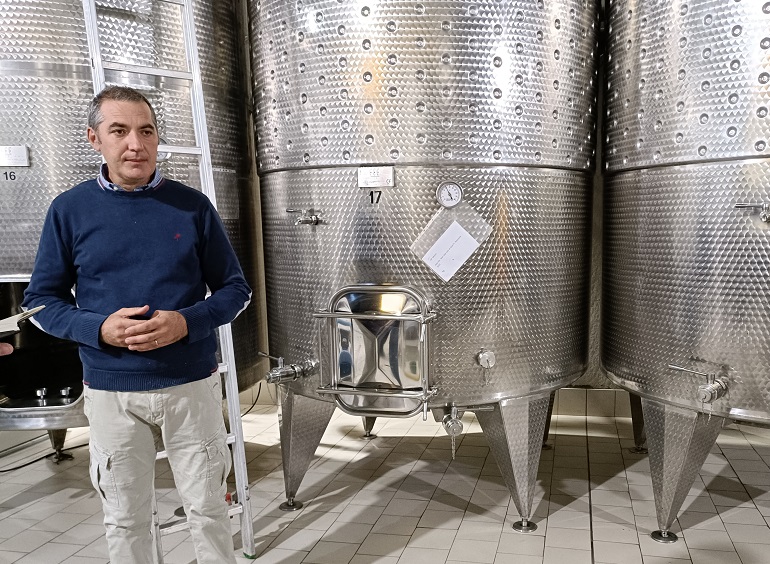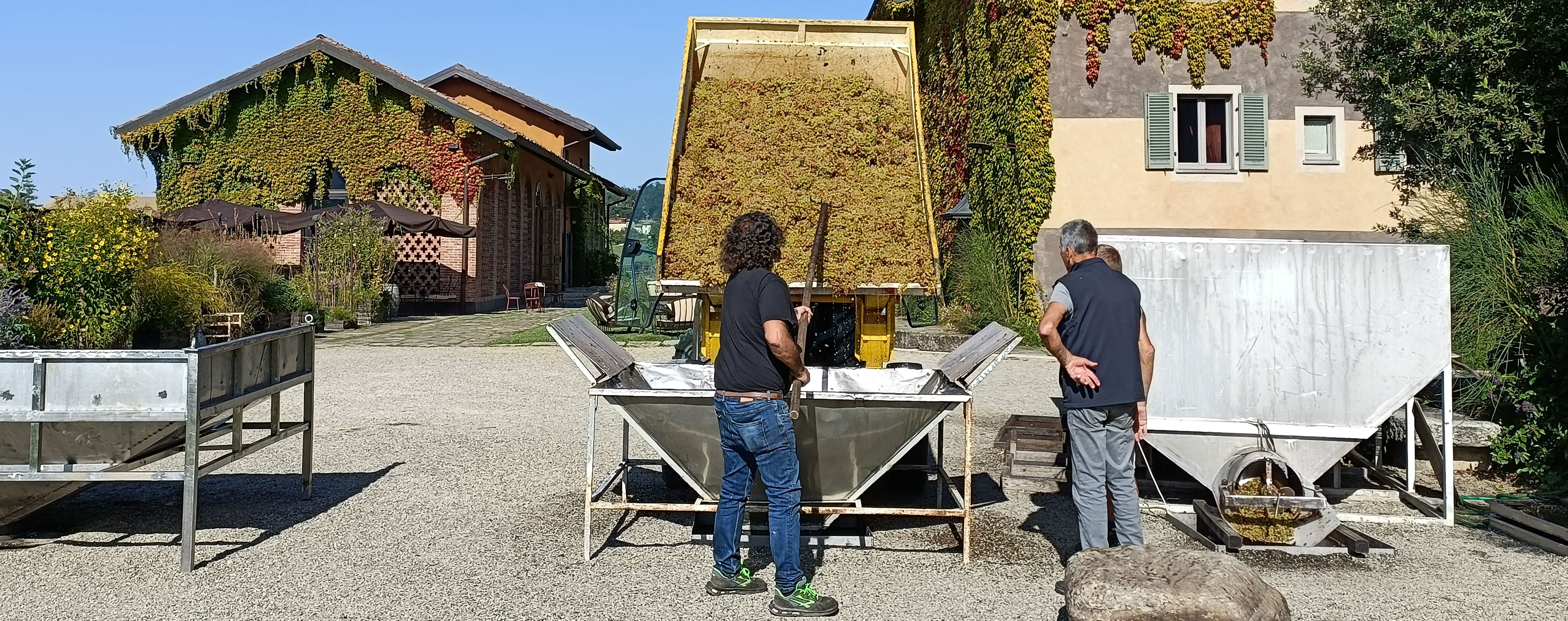It’s been an export success story since merchant ships took Gavi wines from the port of Genoa to the ‘New World’ at the end of the 18th century. Now this part of southeast Piedmont, in the gentle rolling hills between the Mediterranean Sea and the Northern Apennines, produces 13m bottles from 1,580ha of vines – exporting 85% to more than 100 countries, with USA, UK, Germany, Belgium, Denmark, Canada and Japan the key importing nations.
For all these reasons we thought the region and its wine producers could make an interesting case study for Canopy readers, so I visited Gavi during the 2023 harvest.
Typical winemaking

The typical wine from the region is a pale straw yellow colour with greenish reflections. It has distinct and delicate aromas of fresh fruit (especially apples and pears) and white flowers as well as notes of citrus and bitter almonds. Alcohol is usually between 12 and 14% – with the official minimum being 10.5% and 13.5% being the sweet spot in the wines I tasted. A few years ago, the wines were around 11-12%. The wines are also marked by refreshing acidity – with 5g/L the minimum.
They are easy to drink but are viewed as being “more complex, with more personality than Pinot Grigio”.

The only grape allowed for the production of Gavi DOCG wines, Cortese, is a native of Piedmont. The vine is vigorous, producing medium-large clusters of golden-yellow berries (with green or amber reflections when exposed to the sun).
“Our grape, our roots,” Maurizio Montobbio (below), president of the Consorzio Tutela del Gavi, affirms when I meet him in La Guardia, in the centre of the appellation.
After tasting about 60 wines from different producers and chatting with half a dozen, I have drawn up this protocol for making a Gavi DOCG wine.

- Handpicked grapes are chilled in a cold store overnight.
- The following morning they are destemmed and gently pressed (maximum wine grape yield in Gavi DOCG is 70%).
- A few winemakers include a few hours of skin contact; others will let the juice settle overnight before proceeding.
- The juice is inoculated with selected yeast from the region and fermented in stainless-steel tanks at a cool temperature (12-18°C; 16-18°C being the norm). Cortese juice oxidates easily so you have to be very careful with spontaneous fermentations.
- After 12-20 days’ fermentation, the wine is racked off gross lees and into a clean tank.
- It’s left sur lie for three to six months (nine to 12 in some rare cases) at a controlled temperature of 6-10°C with regular bâtonnage.
- After cold stabilisation and filtering, it’s bottled. (March seems to be a popular time for bottling the new vintage, although some do it in February. The main reason, according to Gianlorenzo Picollo (below) of family winery Picollo Ernesto, is so they can ship the wines to the USA in time for summer.)
- The wine ‘refines’ in bottle for three to six months before release.

Only a few producers, as far as I could tell during my short visit, were adding any twists.
- Eredi Guido Gerolamo’s Villavecchia 2022, from vineyards in the highest hills of Gavi, uses cryomaceration. The crushed grapes are put in tanks chilled to 5°C for 36 hours of skin contact. Fermentation then proceeds at 18°C.
- IL Rocchin’s Il Bosco 2021 benefits from 8-10% of wine fermented and aged in barriques, with about a year on lees before blending.

I met Maurizio at La Guardia’s hilltop church, Santuario di Nostra Signora della Guardia. The superb panoramic view shows there is still plenty of biodiversity in the area.
Maurizio confirms the appellation is working in “a sustainable direction”. It’s still a very traditional area, he says, but the ‘sustainable’ trend is growing and wine producers are “opening their minds”.
He mentions the installation of biomonitoring stations for the protection of bees – a project which proves they are heading in the right direction. The project, in collaboration with Aspromiele, involves two hives positioned near the town of Gavi. Pollen samples are taken periodically from June to September and subjected to complete multi-residual analyses. The results show “the existence of environmentally-friendly viticulture within the territory”.
He goes on to outline some of Gavi DOCG’s other projects, such as working with producers to spread the practice of grassing the inter-row areas in vineyards to prevent soil erosion, and promoting organic conversion.
The Consorzio Tutela del Gavi’s chief agronomist, Davide Ferrarese, tells me about some of the typical practices in the vineyards:
- Selective thinning to keep yields of the vigorous variety low. Maximum grape yield allowed in the DOCG is 95 quintals per hectare (65 for riserva wines).
- Canopy management is important, as is binding and positioning of shoots to endure the coastal ‘marin’ wind, which is funnelled up the valley and the hillsides.
The wines from the north tend to have more body and structure. Wines from the central strip tend to have greater balance between structure and flavour, while wines from the south tend to have delicate aromas and marked minerality.
The other trend is the exploration of the ageing potential of Gavis, as this increases and intensifies the impression of minerality. There are increasing quantities of riserva-style wines, with some suggesting aged Gavis could offer an alternative to Chablis. But only four producers print the term ‘riserva’ on their labels.
The minimum requirements for a riserva are alcohol of 11% and one year of refining, of which at least six months should be in the bottle.
With ageing, the wine becomes a golden colour and the aromatic profile becomes more mineral and complex. The Consorzio says a riserva can age for eight to ten years due to the acidity which makes it so refreshing when young.
One of the best examples is Castellari Bergaglio’s Rovereto 2018 from one of the oldest hillside vineyards in the Gavi region. Grapes from vines that are more than 80 years old are left to macerate for several hours at a low temperature, followed by light pressing. Fermentation is at 18-20°C “to maintain the typically rich aromas of the Cortese di Gavi varietal” and lasts for up to 20 days. The wine is bottled in spring and left to age for 12 months before release.
ABV: 13%
TA: 5.2g/L
More inspiration from Gavi: Visiting some of the leading producers













.png)






